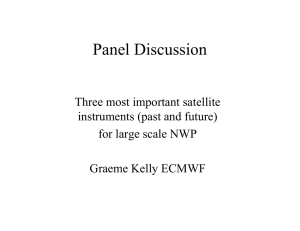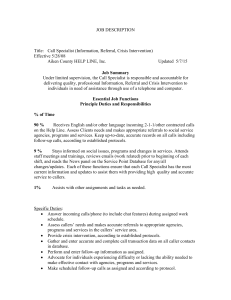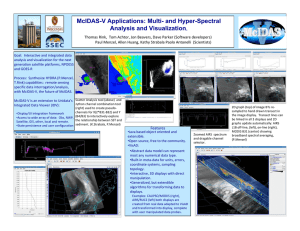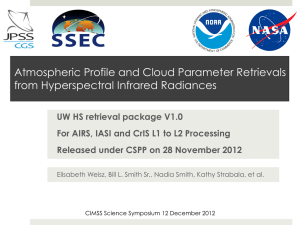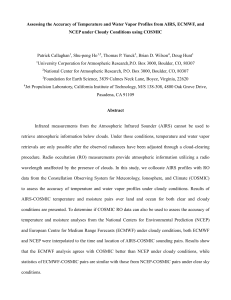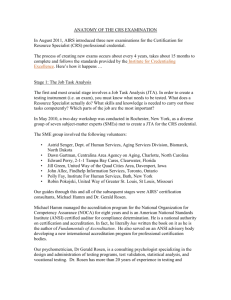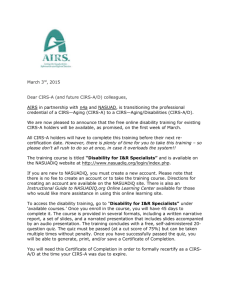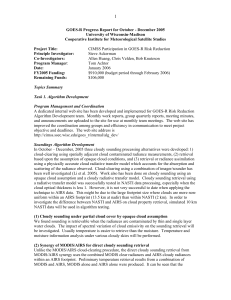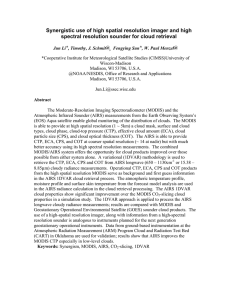Cloudy Sounding and Cloud-Top Height Retrieval from Elisabeth Weisz , Jun Li
advertisement
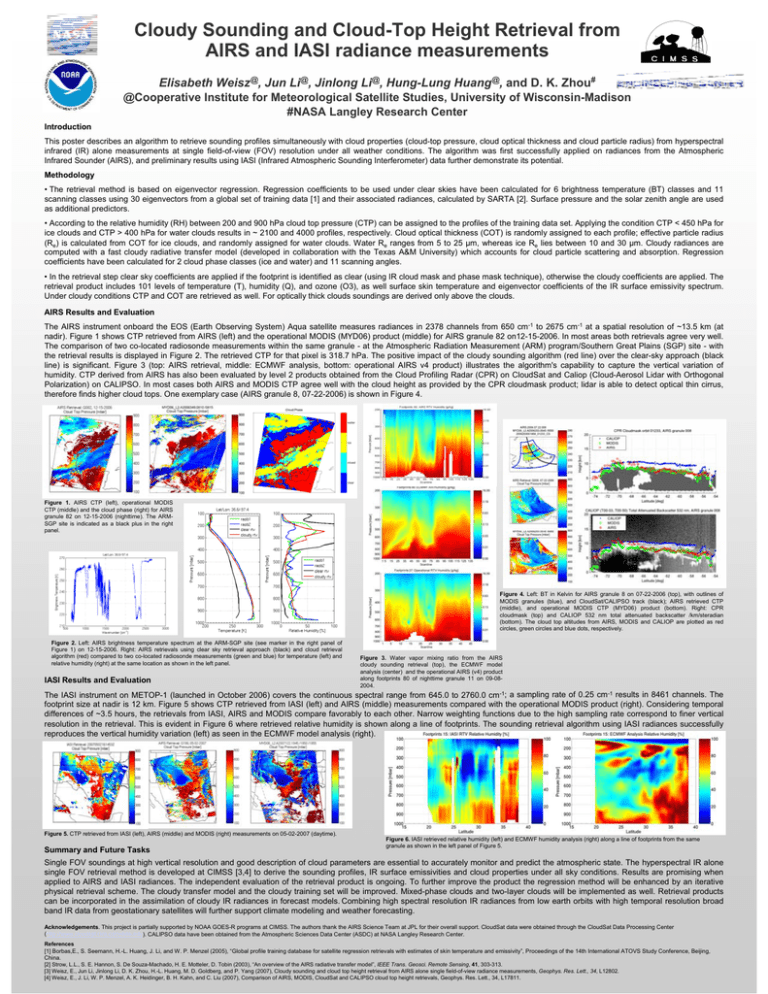
Cloudy Sounding and Cloud-Top Height Retrieval from AIRS and IASI radiance measurements Elisabeth Weisz@, Jun Li@, Jinlong Li@, Hung-Lung Huang@, and D. K. Zhou# @Cooperative Institute for Meteorological Satellite Studies, University of Wisconsin-Madison #NASA Langley Research Center Introduction This poster describes an algorithm to retrieve sounding profiles simultaneously with cloud properties (cloud-top pressure, cloud optical thickness and cloud particle radius) from hyperspectral infrared (IR) alone measurements at single field-of-view (FOV) resolution under all weather conditions. The algorithm was first successfully applied on radiances from the Atmospheric Infrared Sounder (AIRS), and preliminary results using IASI (Infrared Atmospheric Sounding Interferometer) data further demonstrate its potential. Methodology • The retrieval method is based on eigenvector regression. Regression coefficients to be used under clear skies have been calculated for 6 brightness temperature (BT) classes and 11 scanning classes using 30 eigenvectors from a global set of training data [1] and their associated radiances, calculated by SARTA [2]. Surface pressure and the solar zenith angle are used as additional predictors. • According to the relative humidity (RH) between 200 and 900 hPa cloud top pressure (CTP) can be assigned to the profiles of the training data set. Applying the condition CTP < 450 hPa for ice clouds and CTP > 400 hPa for water clouds results in ~ 2100 and 4000 profiles, respectively. Cloud optical thickness (COT) is randomly assigned to each profile; effective particle radius (Re) is calculated from COT for ice clouds, and randomly assigned for water clouds. Water Re ranges from 5 to 25 µm, whereas ice Re lies between 10 and 30 µm. Cloudy radiances are computed with a fast cloudy radiative transfer model (developed in collaboration with the Texas A&M University) which accounts for cloud particle scattering and absorption. Regression coefficients have been calculated for 2 cloud phase classes (ice and water) and 11 scanning angles. • In the retrieval step clear sky coefficients are applied if the footprint is identified as clear (using IR cloud mask and phase mask technique), otherwise the cloudy coefficients are applied. The retrieval product includes 101 levels of temperature (T), humidity (Q), and ozone (O3), as well surface skin temperature and eigenvector coefficients of the IR surface emissivity spectrum. Under cloudy conditions CTP and COT are retrieved as well. For optically thick clouds soundings are derived only above the clouds. AIRS Results and Evaluation The AIRS instrument onboard the EOS (Earth Observing System) Aqua satellite measures radiances in 2378 channels from 650 cm-1 to 2675 cm-1 at a spatial resolution of ~13.5 km (at nadir). Figure 1 shows CTP retrieved from AIRS (left) and the operational MODIS (MYD06) product (middle) for AIRS granule 82 on12-15-2006. In most areas both retrievals agree very well. The comparison of two co-located radiosonde measurements within the same granule - at the Atmospheric Radiation Measurement (ARM) program/Southern Great Plains (SGP) site - with the retrieval results is displayed in Figure 2. The retrieved CTP for that pixel is 318.7 hPa. The positive impact of the cloudy sounding algorithm (red line) over the clear-sky approach (black line) is significant. Figure 3 (top: AIRS retrieval, middle: ECMWF analysis, bottom: operational AIRS v4 product) illustrates the algorithm's capability to capture the vertical variation of humidity. CTP derived from AIRS has also been evaluated by level 2 products obtained from the Cloud Profiling Radar (CPR) on CloudSat and Caliop (Cloud-Aerosol Lidar with Orthogonal Polarization) on CALIPSO. In most cases both AIRS and MODIS CTP agree well with the cloud height as provided by the CPR cloudmask product; lidar is able to detect optical thin cirrus, therefore finds higher cloud tops. One exemplary case (AIRS granule 8, 07-22-2006) is shown in Figure 4. + Figure 1. AIRS CTP (left), operational MODIS CTP (middle) and the cloud phase (right) for AIRS granule 82 on 12-15-2006 (nighttime). The ARMSGP site is indicated as a black plus in the right panel. Figure 4. Left: BT in Kelvin for AIRS granule 8 on 07-22-2006 (top), with outlines of MODIS granules (blue), and CloudSat/CALIPSO track (black); AIRS retrieved CTP (middle), and operational MODIS CTP (MYD06) product (bottom). Right: CPR cloudmask (top) and CALIOP 532 nm total attenuated backscatter /km/steradian (bottom). The cloud top altitudes from AIRS, MODIS and CALIOP are plotted as red circles, green circles and blue dots, respectively. Figure 2. Left: AIRS brightness temperature spectrum at the ARM-SGP site (see marker in the right panel of Figure 1) on 12-15-2006. Right: AIRS retrievals using clear sky retrieval approach (black) and cloud retrieval algorithm (red) compared to two co-located radiosonde measurements (green and blue) for temperature (left) and relative humidity (right) at the same location as shown in the left panel. IASI Results and Evaluation Figure 3. Water vapor mixing ratio from the AIRS cloudy sounding retrieval (top), the ECMWF model analysis (center) and the operational AIRS (v4) product along footprints 80 of nighttime granule 11 on 09-082004. spectral range from 645.0 to 2760.0 cm-1; a sampling rate of 0.25 cm-1 results in 8461 channels. The The IASI instrument on METOP-1 (launched in October 2006) covers the continuous footprint size at nadir is 12 km. Figure 5 shows CTP retrieved from IASI (left) and AIRS (middle) measurements compared with the operational MODIS product (right). Considering temporal differences of ~3.5 hours, the retrievals from IASI, AIRS and MODIS compare favorably to each other. Narrow weighting functions due to the high sampling rate correspond to finer vertical resolution in the retrieval. This is evident in Figure 6 where retrieved relative humidity is shown along a line of footprints. The sounding retrieval algorithm using IASI radiances successfully reproduces the vertical humidity variation (left) as seen in the ECMWF model analysis (right). Figure 5. CTP retrieved from IASI (left), AIRS (middle) and MODIS (right) measurements on 05-02-2007 (daytime). Summary and Future Tasks Figure 6. IASI retrieved relative humidity (left) and ECMWF humidity analysis (right) along a line of footprints from the same granule as shown in the left panel of Figure 5. Single FOV soundings at high vertical resolution and good description of cloud parameters are essential to accurately monitor and predict the atmospheric state. The hyperspectral IR alone single FOV retrieval method is developed at CIMSS [3,4] to derive the sounding profiles, IR surface emissivities and cloud properties under all sky conditions. Results are promising when applied to AIRS and IASI radiances. The independent evaluation of the retrieval product is ongoing. To further improve the product the regression method will be enhanced by an iterative physical retrieval scheme. The cloudy transfer model and the cloudy training set will be improved. Mixed-phase clouds and two-layer clouds will be implemented as well. Retrieval products can be incorporated in the assimilation of cloudy IR radiances in forecast models. Combining high spectral resolution IR radiances from low earth orbits with high temporal resolution broad band IR data from geostationary satellites will further support climate modeling and weather forecasting. Acknowledgements. This project is partially supported by NOAA GOES-R programs at CIMSS. The authors thank the AIRS Science Team at JPL for their overall support. CloudSat data were obtained through the CloudSat Data Processing Center (http://www.cloudsat.cira.colostate.edu). CALIPSO data have been obtained from the Atmospheric Sciences Data Center (ASDC) at NASA Langley Research Center. References [1] Borbas,E., S. Seemann, H.-L. Huang, J. Li, and W. P. Menzel (2005), “Global profile training database for satellite regression retrievals with estimates of skin temperature and emissivity”, Proceedings of the 14th International ATOVS Study Conference, Beijing, China. [2] Strow, L.L., S. E. Hannon, S. De Souza-Machado, H. E. Motteler, D. Tobin (2003), “An overview of the AIRS radiative transfer model”, IEEE Trans. Geosci. Remote Sensing, 41, 303-313. [3] Weisz, E., Jun Li, Jinlong Li, D. K. Zhou, H.-L. Huang, M. D. Goldberg, and P. Yang (2007), Cloudy sounding and cloud top height retrieval from AIRS alone single field-of-view radiance measurements, Geophys. Res. Lett., 34, L12802. [4] Weisz, E., J. Li, W. P. Menzel, A. K. Heidinger, B. H. Kahn, and C. Liu (2007), Comparison of AIRS, MODIS, CloudSat and CALIPSO cloud top height retrievals, Geophys. Res. Lett., 34, L17811.
